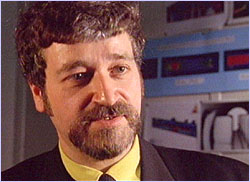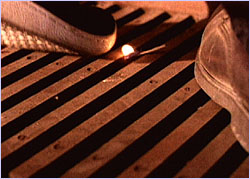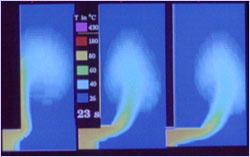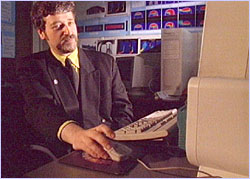
|
 |
 |
Pioneers of Survival All of the safety features you take for granted, from firefighting gear to seat belts, from airplane chutes to life rafts, have gone through extensive design and testing, often with real people serving as guinea pigs. Meet some of the leaders in the field of safety research—people who, in some cases, have not hesitated to put their own lives on the line to improve your safety. Fire | Car | Plane | Ship
NOVA: Why do you think it is that people so often underestimate fire? Galea: I think most people aren't faced with fire in everyday life. We no longer have open fires in our houses, we have central heating. We no longer have fire for cooking, we have electric cooking ranges, and so on. So most people aren't faced with fire. The only time they would probably come across a fire is possibly in a barbecue, or possibly when they have a bonfire. So when a fire incident happens, they forget about how quickly fire can spread, and they forget about how dangerous the actual fire products—the gases and the smoke—can be. So that certainly doesn't help in people's response, or their sense of respect for how dangerous a fire can be.
Galea: The way that people behave in structures is often misunderstood and misreported. If there is an evacuation in a building, what generally hits the headlines is that people panicked, there was a mass stampede, and so on. When you actually go and analyze what happened in these evacuations you often find that in fact people have not panicked. The response that people have to a known fire is to run away from it. And that's not a panic reaction. That's a natural reaction. If you have a fire that's about to burn you, you run away from it as fast as you can. It's a rational response to threat. What we find, though, is that in most instances people are not actually aware that there is a life-threatening situation developing. They might hear an alarm go off and think, "Well, that's usually a false alarm, it could be somebody's car alarm, it could be a burglar alarm," and they tend to ignore it. So they don't respond immediately to the call to evacuate. They mill around, they continue doing what they are doing until they see some sign of a life-threatening situation or until they start seeing other people actually fleeing. Then they turn around and escape.
Galea: Well, in the Bradford Football Fire in England, quite a large fire developed in the stands. People were still sitting around watching the game, watching the fire, and not really trying to get away from it as quickly as possible. And within seconds that small fire developed into a flashover event which took the entire stand. So that's a very good example of where people have just forgotten about the impact of fire, and how quickly fire can spread. NOVA: What is your advice for how crowds should be handled in a fire situation? Galea: I think people need to be made aware of fire events. I think we should convey information to people on the scene, rather than just an alarm sounding. We should convey, for example, a verbal warning—"there is a fire present, please evacuate"—rather than just a bell going off, or a siren going off. People will then tend to take that more seriously, and they tend to react more quickly to those sorts of responses than just simply hearing a bell.
Galea: It started off as quite a small fire under an escalator and rapidly spread onto the escalator. Once it got hold of the wooden escalator, the shape of the escalator and the slope of the escalator caused the rising plume to be entrained down onto the actual rising escalator. Because of that the fire had a channel to spread the gases and the heat and the top products right up into the ticket hall, very, very rapidly. On top of all of this you had trains approaching and departing the actual Underground station itself. Now when a train approaches a station, it's coming in in a tight tunnel, and it's pushing in all the air in front of it. As it enters into the actual platform area all that air is pushed up the escalators, up the staircases. That fanning effect accelerates the combustion process and accelerates the spread of flames on the escalator. That effect spread the fire very, very rapidly. One of the key things that came out of the Kings Cross fire was how quickly the fire developed—once it actually gripped the whole of the escalator—how quickly the whole fire spread and how quickly it grew to a very large size and actually spread in the ticket hall. NOVA: Later on this fire was modeled. What was the significance of this model? Galea: The computer model of the Kings Cross fire was quite pivotal in the development of fire modeling in that we had a fire at Kings Cross that no one could understand. The fire experts couldn't explain why the fire was so severe and why it progressed so rapidly. When the Harwell Laboratory modeled the Kings Cross fire the model suggested a mechanism that explained the entire fire development and why it developed so rapidly. Initially the results were not believed. Then an experiment, where a model of the escalator was built and a fire was lit, confirmed what the computer model had predicted. So here we had for the first time a fire model explaining the cause of a fire that had baffled the experts. Usually it happens the other way around. You do the experiments, you have an explanation, and then you do some modeling. NOVA: Could you explain how computer modeling buildings can help save lives? Galea: By performing a computer simulation of a potential fire and how smoke spreads in a structure, we can get a feel for how the structure will interact with the generated smoke products and the actual fire itself. We can get a feel for how rapidly the structure is going to fill with smoke. We can get a feel for where the smoke is going to go and how the fire is going to spread. So we can design a structure so that—rather than causing a fire to spread more rapidly—it could possibly contain the fire. We can use a computer model while the structure is still on the drawing board to hopefully design a safer building. NOVA: Are these models hard to make? Galea: Yes. When you run a fire field model similar to what was used to simulate the Kings Cross fire, you are taking the volume of the room and dividing it into thousands of little volumes. And in each one of those little volumes you are solving the fundamental equations of fire development. There are only seven or eight of those equations. But they are very complicated, very difficult equations to solve. And you are solving them in each one of these thousands of volumes. So, in fact, you end up with millions of equations to solve. Those millions of equations need to be solved at each point in time; you mark your calculation through maybe every second of the actual fire event. So you not only have millions of equations to solve at one point in time, you have thousands of those millions of equations to solve. So you end up with millions of equations that you have to solve to end up with your fire simulation. This takes a lot of time even on a very powerful computer. Even on a supercomputer it could take weeks to generate a simulation of a fire in a structure, and because of that, the technique is quite expensive.
Galea: Fire field modeling is still a developing and evolving technology, and there are limitations. Predicting the fundamental fire spread on a solid material surface is quite difficult and is an area of research at the moment. Predicting the onset of flashover and also predicting back draft are other areas that are currently under development. We have developed our own computer models and are beginning to be able to simulate flashover and back draft in a fundamental way, but the models are still in the early days of development, and they are restricted to very simple types of solid fuel, such as cellulosic fuels and wood products. NOVA: You did some interesting analysis on a fire in 1993 in Basingstoke, England. Tell us what you learned from that. Galea: The Basingstoke building was a modern structure. It had only recently been built, and it had been designed to be more or less fireproof on the inside. They had designed it using passive fire prevention means, so they had good insulation on all the walls, they had pressurized stair cases, the whole structure was fire blocked, which meant that if a fire started on a floor it would be contained on that floor and it would not spread to the rest of the structure. However, on the evening that they had the fire, the fire started on one of the upper floors, rapidly developed, and engulfed the entire floor. Eventually the exterior glass panels broke, and flames emerged from the fire compartment. What the designers had forgotten to take into account in designing the structure was that it was possible for fire to spread to higher floors via the exterior portion of the building. So when the fire broke the glass, flames emerged from the side of the building and spread fire to the higher floors.
Galea: Yes. You could have a balcony structure—a fixed permanent structure that is perpendicular to the face of the building—or you could have a deployable device so that when a fire breaks out, you have a deployable ledge that comes out perpendicular to the side of the building and deflects the upward moving flame. Computer simulations suggest that this would provide a great deal of protection to the higher floors. As far as I know, no buildings have purposely put in this device as a means to prevent fire spreading to higher floors. NOVA: In addition to developing fire simulation models, you've also developed evacuation models. Can you explain how you predict how people behave in your evacuation model? Galea: In the Exodus evacuation model, we predict the behavior of individual people. The model looks at people-people interaction; how people interact with each other. It looks at people-structure interaction; how people react with the actual building itself, and people-environment; how people respond to the fire, the smoke, the heat, and the toxic gases. We describe people as unique individuals. They have their own sets of attributes, how quickly they can walk, how quickly they're likely to respond to a fire, their knowledge of the building, which exit they're likely to use, their drive, and how keen they are to get out of the structure. So we have a collection of physical attributes that describes individual people. We even have respiration rates—different breathing rates—for people as part of the description of each individual person. All these parameters then interact to describe how that person is going to respond to the particular incident that they're faced with. NOVA: And how do you use that information? Galea: Well, we're using the Exodus computer model while the building is still in the planning phase, to try and design the structure so that it is more efficient in terms of evacuating people. For example, where do you have the exits? What type and how wide should the exits be? What sort of staircases should you have? How many staircases? What sort of procedures should you have? Should you have trained staff, fire marshals in the structure? Where should they be? What should they be doing? So we're using the computer model to try and help design structures and also to look at things such as procedures—how you can train people to manage a fire situation more efficiently. NOVA: Do you think it's possible to design a fireproof building? Galea: I don't think it's possible to design a structure that is one hundred per cent fire proof. Any structure has the capacity to burn. And because it's going to burn, it's going to produce smoke, heat, toxic gases and so on. Because of that, you need to make sure that you can get people out of that structure as quickly and efficiently as possible, and that's why you need evacuation models to help design structures so that the evacuation of people is going to be as efficient as possible. NOVA: What advice do you have for young people who are interested in getting involved in this field? Galea: Fire safety science and engineering is a fascinating subject, because it brings together many different disciplines in the pursuit of a safer environment. A good fire safety scientist/engineer, for example, needs to have an understanding of math, chemistry, physics, physiology, psychology, computer science, engineering, economics, architecture, and many more subjects. This is one of the reasons it is such an interesting subject: You rarely get bored doing the same thing over and over again, and there is always something new to learn. Escape Through Time | Skydive | Human Response Survivor Stories | Pioneers of Survival | Survival Strategies Resources | Teacher's Guide | Transcripts | Site Map | Escape! Home Editor's Picks | Previous Sites | Join Us/E-mail | TV/Web Schedule About NOVA | Teachers | Site Map | Shop | Jobs | Search | To print PBS Online | NOVA Online | WGBH © | Updated November 2000 |
 Professor Edwin Galea
Professor Edwin Galea
 When a fire broke out during a football match in
England, there was little reaction from the nearby
crowd who watched as it grew.
When a fire broke out during a football match in
England, there was little reaction from the nearby
crowd who watched as it grew.
 Soon after it began, the fire in the Bradford
Football stadium transformed into an inferno that
claimed the lives of 53 people.
Soon after it began, the fire in the Bradford
Football stadium transformed into an inferno that
claimed the lives of 53 people.
 In 1987, a small fire under an wooden escalator
quickly spread to the rest of the Kings Cross
Underground Station in London.
In 1987, a small fire under an wooden escalator
quickly spread to the rest of the Kings Cross
Underground Station in London.
 Computer models, such as these, are used with
increasing frequency to study fires.
Computer models, such as these, are used with
increasing frequency to study fires.
 Professor Galea demonstrates that computers not only
can predict the behavior of fires—they can model
human reactions to a fire.
Professor Galea demonstrates that computers not only
can predict the behavior of fires—they can model
human reactions to a fire.